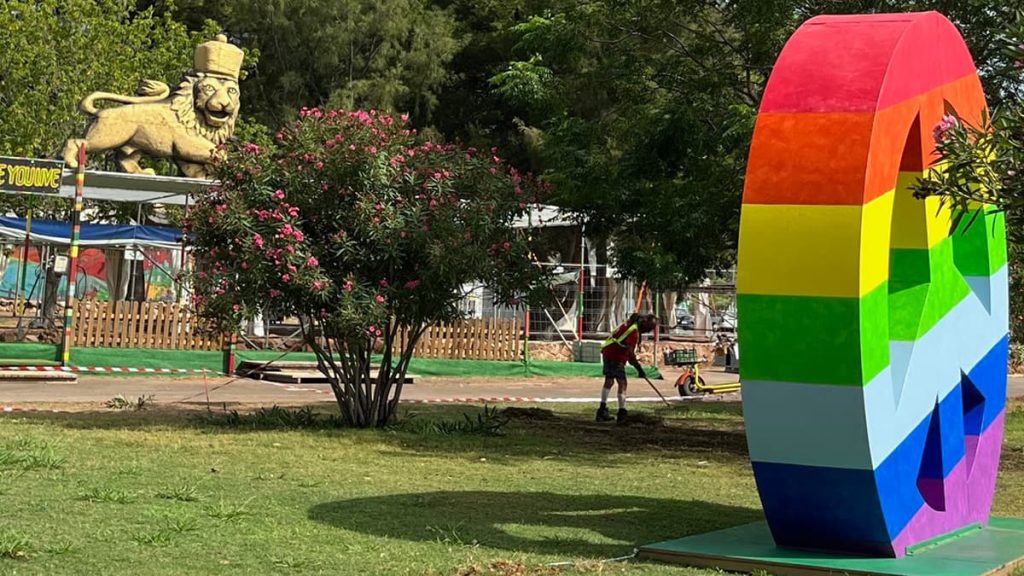From Marley Square, life in the reggae city of Rototom Sunsplash is distributed. The market. The Ramblas with dozens of restaurants, bars and cafes with gastronomic proposals from around the world. An open-air art gallery. Neighborhoods’ full of culture and leisure: from the African Jamkunda to Pachamama, the thoughtful Social Forum or the acclaimed by children and teenagers Magicomundo and Teen Yard. An extensive camping area, green areas and rest areas. And, above all, music: up to six meeting points with Jamaican sounds as the epicenter.
The reggae city of Rototom Sunsplash in Benicàssim – totally accessible – will be visited daily by 30,000 people – the same number as in Teruel, or the nearby Borriana or Vinaròs, also on the Mediterranean coast – from more than 70 countries. For 20 days, a team of 74 people worked against the clock to install the necessary services to serve the population: water and selective waste collection points, piping, bathrooms, sanitary facilities and the installation of up to 7 kilometers of cabling. Also to erect the structures, stages, tents and carefully designed scenographies that make up this reggae universe that emerges every summer from August 16 to 22 at the Benicàssim Concert venue. The same one that hosts other macro festival events, such as FIB and SanSan, but to which Rototom gives an idiosyncrasy recognizable from anywhere on the planet, thanks to its replicas of the iconic lion and the omnipresent green, yellow and red.

Twenty days and 148 professional hands in engineering, plumbing, IT, sustainability, security, sound, electricity, assembly, transportation, work at heights and scenery, among other sectors. This is what is needed for the optimal filming of a festival that extends over an area of more than 300,000 square meters (the 108,000 square meters of the site and the 194,000 square meters of the camping area, with a capacity for 9,000 people). A surface on which the six Rototom Sunsplash stages (Main Stage, Lion Stage, Jamkunda Stage, Jumping, Dub Academy and Dancehall), the two market areas, the extra-musical areas (Teen Yard, Magicomundo, Pachamama, Foro Social, Reggae University), the four gastronomic spaces, the itinerant radio studio, the ticket offices and the logistics, backstage, production and media office areas are located.
It has taken months to draw up a map of the site. Three. However, the architectural design of this reggae city is initiated practically a few weeks after the end of each edition. This work includes a meticulous study of the anchoring and fastening of structures and scenery -the festival’s own design team plans them on a blueprint so that nothing fails during their installation on site- and of the evacuation systems in case of emergency. All this without neglecting the analysis of weather conditions to cope with the heat or possible rain or the implementation of the necessary measures to control the capacity to avoid crowds, given the family and inclusive profile of the festival.
The proximity policy advocated by the festival is well reflected in the staging. 70% of the nearly 200 companies that collaborate with Rototom Sunsplash are local, from the province and the Valencian Community. 100% of the plumbing and transport service is from Castelló; as for electricity, 65% of the firms are from Benicàssim and 35% from Valencia; 60% of the sound is managed from the province -and the rest between Valencia and Barcelona-; while for work at heights, professionals from Benicàssim and the capital of the Túria are used.
The festival’s set-up is also sustainable: it is committed to the reuse and reuse of materials year after year, without undermining safety or creativity. Creativity that, in this edition, wrapped under the slogan ‘United for Peace’ and with the help of the festival’s scenography team, gives a twist and lands with great news, which will be unveiled to the public from August 16.

As a preview, the featured changes will burst onto the stages. The Main Stage will be the flag bearer of the appeal for peace that the festival wants to launch this summer with its reformulated staging. For its part, the Dancehall is renewed with an ‘on fire’ design and also the Dub Academy, which incorporates a new hemispherical structure in the form of a large format igloo (30 meters in diameter and almost 15 meters high). Lion Stage expands its ornamental elements and, although it maintains its location, it moves slightly to gain visibility and increase its seating capacity.
The scenography at the entrances to the festival and the Jamkunda area has also changed. And, as every year, the Bob Marley sculpture that crowns the square of the same name is renewed. That square, essential in any town, intercultural meeting point, from which life is distributed in the city of reggae, ephemeral but eternal, the Rototom Sunsplash.
